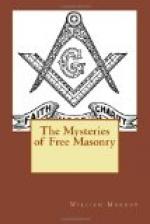Q. What followed? A. The Most Excellent Prelate then directed me to rise and be invested with a countersign, which he informed me would enable me to make myself known to the friends of our cause wherever I should meet them, and would insure me from them succor, aid, and protection. [Here the Master of Infantry, who is the conductor, gives the candidate the Jewish countersign; it is given under the arch of steel; that is, their swords elevated above their heads, forming a cross, each placing his left hand upon the other’s right shoulder, and whispering alternately in each other’s ear the names of Judah and Benjamin.]
Q. What followed? A. The Most Excellent Prelate then invested me with a green sash, as a mark of our particular friendship and esteem; you will wear it as a constant memorial to stimulate you to the faithful performance of every duty, being assured that the memory of him, who falls in a just and virtuous cause, shall forever flourish like the green bay tree.
Q. What followed? A. I then commenced my journey, and was frequently accosted by guards, all of which, by means of the countersign I had received, I was enabled to pass in friendship, until I arrived at the bridge, which was represented to be in the Persian dominions; on attempting to pass this bridge, which I found strongly guarded, the Persian countersign was demanded, and being unable to give it, I was attacked, overpowered, and made prisoner.
Q. What followed? A. After remonstrating in vain against their violations, I told them I was a prince of the house of Judah, and demanded an audience with their sovereign.
Q. What was the answer? A. You are a prisoner, and can obtain an audience with the sovereign only in the garb of a captive and slave.
Q. Did you consent to this? A. I did; being firmly persuaded that could I by any means gain access to the presence of the sovereign, I should be able to accomplish the object of my mission.
Q. What followed? A. They then deprived me of my outward apparel, sash and sword, and having confined my hands and feet in chains, the links thereof were of a triangular form, they put sackcloth and ashes on my head.
Q. Why were the links of the captive’s chain of a triangular form? A. The Assyrians having learned that among the Jews the triangle was an emblem of the Eternal, caused the links of their chain to be made of a triangular form, thinking thereby to add to the miseries of their captives.
Q. What followed? A. I was conducted to the door of the Council chamber, where the alarm being given by 4 x 2, the Warder appeared and demanded, “Who comes there?”
Q. What answer was returned? A. A detachment of his majesty’s guards, having made prisoner of one, who reports himself to be prince of the house of Judah.




